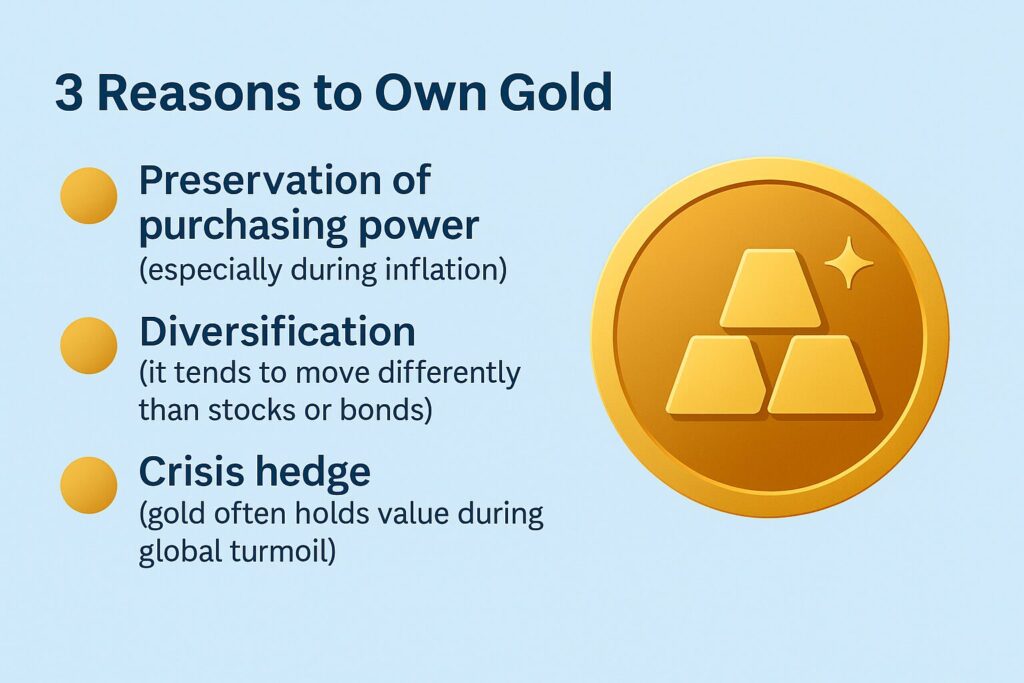
Use gold as a stabilizer—not a gamble—for long-term security and peace of mind.
Gold has long been considered a “safe haven” asset, especially during times of inflation, geopolitical tension, or market uncertainty. But as a retiree, you may be asking a practical question:
How much gold should I actually own?
The short answer? Enough to protect—but not so much that you sacrifice income or growth.
Let’s explore how to use gold strategically in retirement, including clear percentage guidelines, the role it plays in your portfolio, and how to strike the right balance for both safety and long-term stability.
✅ Why Retirees Consider Gold
Gold offers three core benefits:
- Preservation of purchasing power (especially during inflation)
- Diversification (it tends to move differently than stocks or bonds)
- Crisis hedge (gold often holds value during global turmoil)
Unlike stocks, gold doesn’t pay dividends. But unlike bonds, it’s not subject to interest rate risk. That makes it a non-correlated asset—one that helps steady your portfolio when other parts are shaky.
✅ How Much Gold Should You Own?
Here are some general, retirement-friendly guidelines:
🔹 5% – A Conservative Hedge
A small allocation can provide a buffer against inflation and market crashes without pulling too much capital away from income-generating assets.
✅ Best for: Conservative retirees focused on income and capital preservation.
🔹 10% – A Balanced Allocation
This is the most common target for retirees who want meaningful protection without going “all in.” A 10% gold allocation smooths out volatility and protects against financial system risk.
✅ Best for: Retirees looking for a stable middle ground—growth, income, and safety.
🔹 15% or more – For the Cautious or Inflation-Conscious
If you’re deeply concerned about long-term inflation, dollar weakness, or global instability, a larger allocation might offer peace of mind.
✅ Best for: Those who value security and capital preservation above yield or growth.
⚠️ Note: Allocating more than 20% to gold in retirement may limit your portfolio’s ability to generate income or grow over time.
✅ Real-Life Example: Martha’s Golden Balance
Martha, 72, lives off a mix of Social Security, dividends, and bond income. After watching inflation erode her purchasing power in 2022, she added a 10% allocation to gold ETFs in her IRA.
The result? Her overall portfolio became more stable, and she slept better knowing she had a hedge against inflation and economic surprises—without giving up income from her stocks and bonds.
✅ What Types of Gold Investments Make Sense?
You don’t need to store gold bars under your bed. Retirees can access gold in several safe, convenient ways:
- Gold ETFs like GLD or IAU – Easy to buy/sell, no storage hassles
- Physical gold coins – Tangible, but requires secure storage
- Gold mining stocks – Offer leverage to gold price, but more volatile
- Gold mutual funds or closed-end funds – Professionally managed exposure
✅ Tip: For simplicity and liquidity, most retirees choose gold ETFs inside an IRA or brokerage account.
✅ The Bottom Line
You don’t need to bet everything on gold to benefit from its safety. For most retirees, a 5% to 10% allocation is enoughto add resilience to your portfolio without sacrificing income or growth potential.
Gold isn’t an all-or-nothing asset—it’s a stabilizer, not a speculator’s gamble.
Done right, it can give you peace of mind, protection, and smart diversification in uncertain times.
⚠️ Disclaimer
This content is for educational and informational purposes only. It does not constitute financial, investment, or tax advice. All investing involves risk, including the potential loss of principal. Consult a qualified financial advisor before making any investment decisions. The author is not a licensed financial professional and does not offer personalized investment advice.